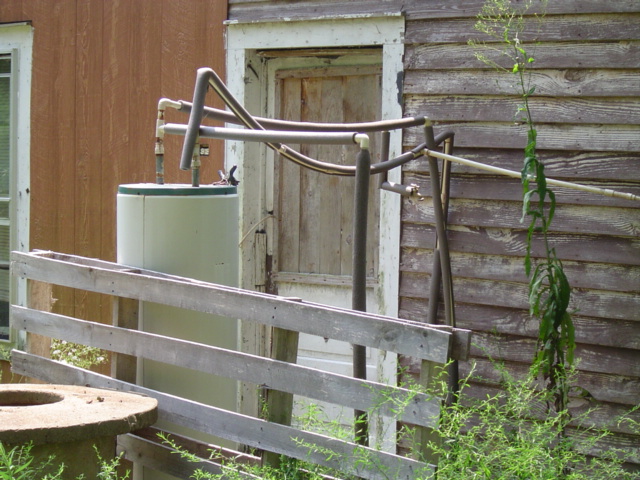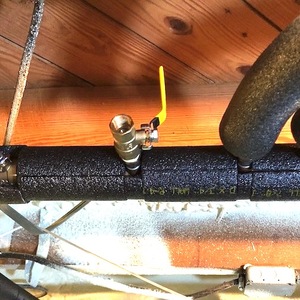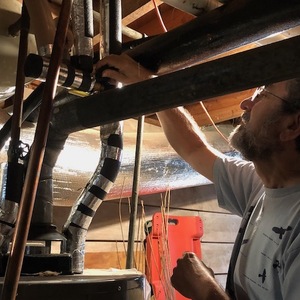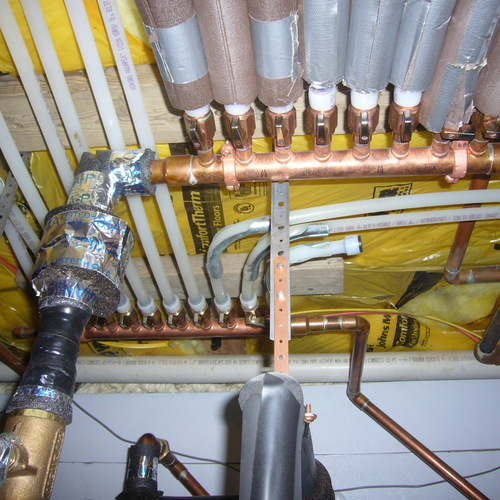
A lot of people complain that it takes a long time to get hot water at one or more of their hot water fixtures. In my case it’s the kitchen sink. I’ve measured it many times, and it takes two and a half minutes for hot water to arrive there. While I’m waiting for the hot water, 3 gal. of water go down the drain. Then after I turn off the water, another 3 gal. of hot water is left stranded in the pipes between the kitchen and the water heater. So I waste water on the front end, energy on the back end, and spend time waiting that I’d rather use doing something else. Does it really need to be so bad?
The basic problem
When you think it through, it’s easy to see that hot water distribution suffers because of one basic problem. When 3 gal. of water spill out of my kitchen faucet while I wait for hot water, that tells me something about the volume in the hot water line between the water heater and the kitchen faucet. To waste less water, I need less water to be sitting in that pipe. That’s it. That’s the problem.
The actual amount of wasted water, however, is often greater than the water sitting in the pipes. That’s the structural waste. But when hot water flows through pipes that are too large, it doesn’t just push everything in front of it until all of the structural waste is out of the pipe and the hot water arrives at the tap. The hot water mixes with the water already in the pipe and sometimes rides on top of the water in the pipe. That lengthens the time to get hot water as well as the amount of water wasted. (See Figure 2 in this Journal of Light Construction article by Gary Klein (pdf) for a visual.)
If you look at some of the plumbing company’s websites, they’ll give you the right answer . . . partly. But they add several other things, including sediment buildup, undersized water heater, and outdoor temperature, that have nothing to do with how fast the hot water arrives. The real reason it takes so long is the volume of water that has to be flushed from the pipe before hot water flows from the tap. To get less water in the pipe, you need shorter, smaller pipes.
Stay with me as I explain this. Yes, you can get hot water faster without changing out your hot water distribution system. I know that can be difficult and expensive in existing homes. But it’s possible to do some partial measures that can help.
Pipe length
The first part of the problem is excessive pipe lengths. That results from the design of a house and its plumbing system. The big reason is that the water heater and the wet rooms (i.e., the rooms where water is used) are too spread out. When you put a water heater in an attached garage, for example, and a bathroom on the opposite end of the house, there’s a whole lot of pipe for the hot water to traverse on its way to the showerhead. The solution is shorter pipes through designing a floor plan that clusters all the wet rooms in one part of the house . . . or at least a design that doesn’t spread them out as far as possible.

Another reason for excessive pipe lengths is the design of the water distribution system that connects the water heater to the fixtures. Hot water pipes rarely take the shortest distance from the water heater to a fixture. In my house, a pipe going straight from the water heater to the kitchen faucet would be about 40 ft. long. The actual hot water pipe is about 80 ft. long.
Pipe diameter
The second part of the problem is that the pipes are too big in diameter. Why are pipes too big? Because our plumbing fixtures have gotten more efficient but the way we design distribution systems hasn’t kept pace with fixture changes. Flow rates of plumbing fixtures are far lower than they used to be, especially since the 1992 Energy Policy Act went into effect. Showerheads, for example, went from flow rates of 3.5 or more gallons per minute (gpm) to 2.5 gpm, a drop of 37% or more. Dishwashers and washing machines cut their flow rates in half. When you cut the flow rate in half, you double the time it takes for hot water to reach the fixture.
The low-flow fixtures we use now certainly save water. They even save hot water but only after the hot water arrives and you’re actually using it. Without an efficient hot water distribution system, you still waste at least as much hot water as the high-flow fixtures while you’re waiting for it to arrive at the tap. We wasted water faster in the old days because that water sitting in the pipes got pushed out faster with higher flow rates.
Putting a low-flow fixture at the tap hasn’t changed the volume of water in the line, the structural waste. It simply reduced the flow rate while leaving the same amount of water to push through before hot water can arrive. As mentioned earlier, though, the reduced flow rate may result in even more wasted water.
With low flow, the hot water doesn’t come rushing through the pipe, pushing everything in front of it all at once. That kind of displacement flow, or plug flow, doesn’t happen with low flow rates in larger pipes. The velocity is low enough that mixing occurs, which increases the time it takes to get hot water and the amount of wasted water.
The keys, then, are to decrease the amount of water sitting in the pipes and also size the pipe diameters for good flow patterns.
What can you do?
Most of the online resources offering solutions to this problem come from plumbing companies. Be wary of their advice because many of them want to sell you a tankless water heater or recirculation pump. Some even tell you to install fixtures with higher flow rates. That last one is really annoying because we’ve had low-flow fixtures for nearly 30 years now. Yes, the early low-flow fixtures weren’t as effective, but engineers have solved those problems. My kitchen faucet (shown above) works really well at 1.2 gpm.
Here are a few solutions to the hot water delivery problem, starting with the most comprehensive.
- Reduce the length and diameter of your hot water pipes. This is easy and inexpensive, if you’re designing a house. For existing homes, do what you can. If you have an opportunity to change the floor plan during a big renovation, cluster the wet rooms.*
- Move the water heater to a more central location. Again, easier to do in the design phase.
- Use two or more water heaters. If you’ve got one hot water fixture far from the water heater, consider a small water heater just for that use.
- Install a demand hot water recirculation system. Continuous recirculation can add a lot to your water heating costs. Putting a continuous recirculation system on a timer can help. Best is to use the demand-type recirculation system. Push a button, wait a few minutes, and your hot water is ready to flow from the tap without wasting water in the meantime. The Building America Solutions Center has a good description of how demand hot water recirculation works.
When I remodel my basement next year, I’m going to replace the hot water distribution system. I’m not changing the floor plan, so I’ll be limited in how much I can reduce the pipe lengths, but I can certainly cut the pipe diameter significantly. Right now, I have a 3/4-in. copper pipe running all the way to the kitchen. That’s the last fixture and a good 20 ft. past the second-to-last fixture. I should be able to cut the pipe diameter to 3/8 in. for the last section. Along with the little bit of length reduction I can get, I should be able to cut my wait time from 2.5 min. to 30 sec. or less. That’s still too long, though, so I’ll also install a demand recirculation system.
Always try to address the real source of any problem. In the case of hot water taking too long to get to the tap, the primary problem is the volume of water in the pipes. Reducing that volume with shorter, smaller pipes is the best way to go. If that still doesn’t get your wait time down enough, use a demand hot water recirculation system.
_________________________________________________________________________
Allison Bailes of Atlanta, Georgia, is a speaker, writer, building science consultant, and the founder of Energy Vanguard. He has a PhD in physics and writes the Energy Vanguard Blog. He is also writing a book on building science. You can follow him on Twitter at @EnergyVanguard. Images courtesy of author.
* Caution: I’m giving general advice here. If you want to reduce the diameter of your plumbing pipes, it’s a good idea to pay attention to plumbing codes and, more important, physics. If you’re not a licensed plumber or building professional, find someone who can help you make the right decisions.
Weekly Newsletter
Get building science and energy efficiency advice, plus special offers, in your inbox.















12 Comments
What's the efficiency of under sink on-demand electric hot water heaters?
John: They use electric resistance heating, so they have a coefficient of performance of one. A heat pump water heater has an efficiency 3 or 4 times higher than that, but it might make sense to install a point-of-use electric resistance heater for some applications if the distribution efficiency is really bad and can't be fixed easily.
An under-sink heater delivers almost instantaneously - so there is almost no wasted water. Using a metric of $/used-gallon, efficiency can exceed a heat pump water heater.
For small draws, the under-sink heater does all the work. For very large draws, the main water heater (which supplies the under-sink one) does most of the work. So overall system efficiency can be hard to predict.
Consider legionella risk for any system that doesn't send stale, previously heated water down the drain.
As you mention, a 3/4 line running from the last fixture to your ks isn't needed and could/should be reduced to 1/2. Another thing you can do/try is remove the restricting washer inside the aerator.....and/or make sure it is not clogged up in the screening. Closing the shut off valve under the sink slightly is a better means of reducing water flow.
Low flow kitchen, tub and utility faucets are a major pet peeve of mine. They serve no positive function. When I do dishes, I'm going to put a fixed amount of water in the sink. The only function the low flow faucet serves is to increase the wait time for hot water, and for filling in general. It makes no sense. In the rare cases where I'm using hot water in real time, I'm perfectly capable of just setting the flow lower with the knob. Low flow should really only exist on shower faucets. Even bathroom faucets don't need it.
I designed my house with all the cited principles in mind. The utility room is right beside the kitchen and bathroom downstairs and below the bathroom upstairs. The longest run is to the kitchen sink, a 1/2" PEX line, maybe 25' because it has to go up to the ceiling and back down to below the sink. Takes upwards of 20s to get hot water there, which is excruciatingly long, given there was really nothing else I could have done. In retrospect, I suppose I could have gone down to 3/8" PEX, but no one was suggesting that.
Trevor, I understand what you're saying, but I disagree in general. I've watched countless people run water (usually hot) continuously while washing dishes and while shaving. There are a lot of people that just don't conserve anything unless it's done for them automatically.
Trevor, I agree with you on the bathtub and utility faucet, but not for the kitchen sink. We almost never use it to fill the sink at my house, but we do use it when rinsing dishes. I find that 1.2 gallons per minute works just fine for that. On the rare occasion when we do fill the sink, I'm OK with waiting.
Regarding your 20 second wait time, yeah, a 3/8" pipe would have reduced that significantly. A 0.5" pipe holds almost twice the volume of water as 3/8" pipe. But I'd love to have a wait time of only 20 seconds.
Great article, as usual. I added a 2.5 gal Stiebel next to my on-demand gas heater and a 2.4kW on-demand electric under the kitchen sink (the furthest faucet). The Stiebel cuts off about 10 seconds (heat up time for on-demand gas) and the line to the kitchen sink is in conditioned space (room temperature) so the 2.4 kW kicks in to heat room temperature water until the Stiebel water arrives. The 2.4kW shuts off once the inlet temperature is above 95F. Thus, even when the kitchen sink is full on, within a few seconds the water does not feel "cold". And, if I want it hot fast for a short time (e.g., hand washing), I turn it on at around 0.5 GPM and the 2.4kW kicks it up to about 95F. I have no disposal so used the dedicated disposal circuit for the 2.4kW on-demand. The kitchen sink gets (1) 2.4kW on-demand electric followed by (2) 2.5 gal Stiebel followed by (3) never ending on-demand gas. Did not want to install recirc.
Thanks. At least we now have manifold systems available so that we have the option of running 1/2" and 3/8" lines when appropriate. Standard practice back in the day was to run 3/4" copper everywhere and tee off with 1/2" lines to the fixture. A 3/8" line to a bathroom vanity is usually plenty IMO but sometimes have difficulty convincing plumbers of that.
Great article. It got me thinking, I could install a hose bibb in the shower at 7-15 gpm to quickly dump the volume of the pipes. The shower is at the opposite end of the heater in a very wide ranch home and currently takes several minutes for the water to get hot.
Here's an article I found on the cost and energy waste of a recirculating pump:
https://www.treehugger.com/ask-pablo-will-a-water-saving-hot-water-recirculation-pump-really-save-me-money-4858682
My bathroom sink faucet has a very low gpm rate, so it takes forever to get hot water if I only open this faucet. To quickly flush out the cold stale water from the hot water pipes, I also open the hot water on my bathtub faucet, which has a much higher gpm rate (probably 4x the sink faucet). Instead of getting hot water in 1-2+ minutes, this method gets me hot water in 20 seconds.
No one has mentioned pipe insulation but I made a huge improvement in my summer camp with exposed pipes under the house. Inexpensive pool noodles that are 3” dia and 4’ long kept my kitchen sink water warm for at least an extra hour vs the 2-3 minutes from before. Total cost was about $10.
Log in or create an account to post a comment.
Sign up Log in